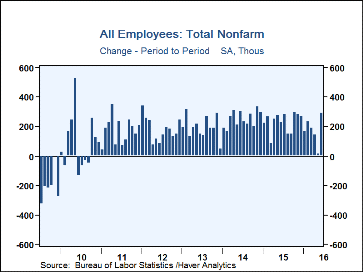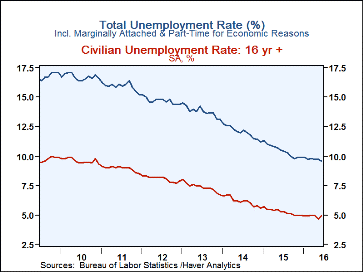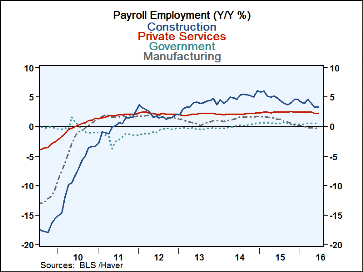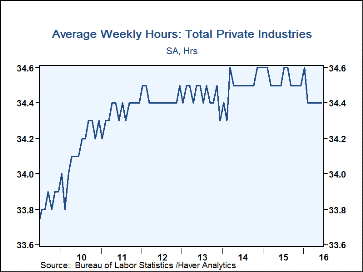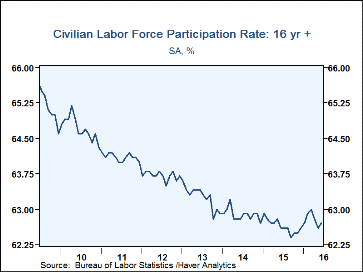 Global| Jul 08 2016
Global| Jul 08 2016U.S. Payroll Gain Bounces Back
by:Tom Moeller
|in:Economy in Brief
Summary
Nonfarm payrolls grew 287,000 during June, a figure boosted as roughly 35,000 Verizon workers returned from strike. Employment increased 11,000 in May, revised from 38,000 and April's gain was revised to 144,000 from 123,000. [...]
Nonfarm payrolls grew 287,000 during June, a figure boosted as roughly 35,000 Verizon workers returned from strike. Employment increased 11,000 in May, revised from 38,000 and April's gain was revised to 144,000 from 123,000. Expectations had been for a 180,000 job increase in the Action Economics Forecast Survey. Improved job readings were widespread. The unemployment rate moved up, however, to 4.9%. A 4.8% rate had been expected. The overall unemployment rate, including workers marginally attached and part-time for economic reasons, eased to 9.6%. Average hourly earnings ticked 0.1% higher versus expectations for a 0.2% rise.
The gain in payrolls last month reflected a 14,000 increase (-0.2% y/y) in factory sector payrolls as they bounced back from a 16,000 decline. Construction sector jobs, however, remained unchanged (3.4% y/y) following two months of decline. Mining sector jobs declined 6,400 (-16.5% y/y), down in each month since October 2014.
In the private service sector, payrolls increased 256,000 (2.3%). The increase was led by a 59,000 increase (2.8% y/y) in leisure & hospitality employment, which was the largest rise since November. Health care & social assistance jobs grew 58,400 (3.2% y/y), also the largest gain since October. Information sector employment improved 44,000 (1.7% y/y) after a 39,000 decline which included the strikers. Professional & business service jobs grew 38,000 (2.7% y/y), aided by a 15,200 increase (0.8% y/y) in temporary help employment. Jobs in retail trade grew 29,900 (2.0% y/y) after a 3,000 increase and financial sector employment rose 16,000 (2.1% y/y), about the same as in the prior three months. Jobs in wholesale trade gained 3,600 (0.9% y/y) following a 4,400 decline. In the public sector, total employment rose 22,000 (0.6% y/y). Federal government jobs grew 2,000 (1.1% y/y). State employment rose 3,000 (0.1% y/y) and local government employment rose 17,000 (0.6% y/y).
The length of the average workweek remained at 34.4 hours for the fifth straight month. That was shorter than the 34.6 hour peak seen as recently as January. The factory sector workweek has been stable around 40.7 hours since April of last year, but that's down from the 2014 peak of 41.1 hours. The private service sector workweek has been stable at 33.3 hours for five months. Financial sector hours of 37.6 compare to the leisure & hospitality workweek of 26.0 hours. Aggregate hours worked (employment times hours) grew 0.2% last month and rose 0.8% (AR) last quarter.
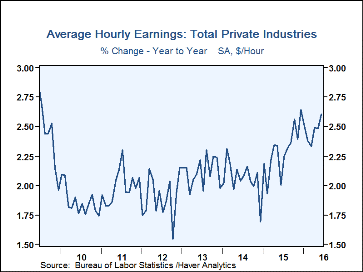 Average hourly earnings ticked 0.1% higher, the weakest increase since
February. Nevertheless, the y/y rise increased to 2.6% which matched the
strongest gain since July 2009. Mining sector wages grew 3.7% y/y and factory
sector wages grew 3.4% y/y; construction wages advanced 2.8% y/y. In the private
service sector, wages rose 2.5% y/y led by a 4.8% rise in information services
and 4.3% growth in leisure & hospitality. Professional & business
service wages improved 2.4% y/y and education & health services wages
improved 1.9% y/y.
Average hourly earnings ticked 0.1% higher, the weakest increase since
February. Nevertheless, the y/y rise increased to 2.6% which matched the
strongest gain since July 2009. Mining sector wages grew 3.7% y/y and factory
sector wages grew 3.4% y/y; construction wages advanced 2.8% y/y. In the private
service sector, wages rose 2.5% y/y led by a 4.8% rise in information services
and 4.3% growth in leisure & hospitality. Professional & business
service wages improved 2.4% y/y and education & health services wages
improved 1.9% y/y.
From the household sector employment survey, the rise in the unemployment rate to 4.9% reflected a 67,000 increase (1.6% y/y) in employment and a 414,000 (1.2% y/y) in the labor force, which followed two months of decline. The labor force participation rate notched up to 62.7%, but remained below March's high of 63.0%. The number of persons not in the labor force rose 0.9% y/y, the slowest y/y gain since 2.9% in 2010.
The teenage unemployment rate held steady m/m at 16.0%, down from the 2009 high of 27.2%. For those aged 25 and over the rate was 4.0%. The group with lowest jobless rate was 45-54 years old at 3.5%.
By educational attainment, individuals without a high school diploma realized 7.5% unemployment. High school graduates had a 5.0% unemployment rate and those with some college or an associate degree were 4.2% unemployed. College graduates realized 2.5% unemployment.
The labor market data are contained in Haver's USECON database. Detailed figures are in the EMPL and LABOR databases. The expectations figure is in the AS1REPNA database.
| Employment: (SA, M/M Change, 000s) | Jun | May | Apr | Jun Y/Y | 2015 | 2014 | 2013 |
|---|---|---|---|---|---|---|---|
| Payroll Employment | 287 | 11 | 144 | 1.7% | 2.1% | 1.9% | 1.6% |
| Previous | -- | 38 | 123 | -- | -- | -- | -- |
| Manufacturing | 14 | -16 | 5 | -0.2 | 1.1 | 1.4 | 0.8 |
| Construction | 0 | -16 | -6 | 3.4 | 4.8 | 5.0 | 3.7 |
| Private Service-Producing | 256 | 35 | 159 | 2.3 | 2.5 | 2.1 | 2.1 |
| Government | 22 | 17 | -3 | 0.6 | 0.5 | 0.0 | -0.3 |
| Average Weekly Hours - Private Sector | 34.4 | 34.4 | 34.4 | 34.5 (Jun'15) |
34.5 | 34.5 | 34.5 |
| Private Sector Average Hourly Earnings (%) | 0.1 | 0.2 | 0.3 | 2.6 | 2.3 | 2.1 | 2.1 |
| Unemployment Rate (%) | 4.9 | 4.7 | 5.0 | 5.3 (Jun'15) |
5.3 | 6.2 | 7.4 |
Tom Moeller
AuthorMore in Author Profile »Prior to joining Haver Analytics in 2000, Mr. Moeller worked as the Economist at Chancellor Capital Management from 1985 to 1999. There, he developed comprehensive economic forecasts and interpreted economic data for equity and fixed income portfolio managers. Also at Chancellor, Mr. Moeller worked as an equity analyst and was responsible for researching and rating companies in the economically sensitive automobile and housing industries for investment in Chancellor’s equity portfolio. Prior to joining Chancellor, Mr. Moeller was an Economist at Citibank from 1979 to 1984. He also analyzed pricing behavior in the metals industry for the Council on Wage and Price Stability in Washington, D.C. In 1999, Mr. Moeller received the award for most accurate forecast from the Forecasters' Club of New York. From 1990 to 1992 he was President of the New York Association for Business Economists. Mr. Moeller earned an M.B.A. in Finance from Fordham University, where he graduated in 1987. He holds a Bachelor of Arts in Economics from George Washington University.


